In this week’s column, we welcome the release of new editions of some old favorites. Join us in celebrating the anniversaries of these picture books and novels that were loved by readers when they were first published and make exciting and meaningful reading for those discovering them for the first time.
Ages 4–8
Borka: The Adventures of a Goose With No Feathers. John Burningham. 2018. Candlewick.
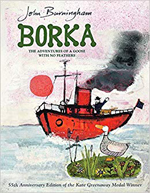 In the spring, Mr. and Mrs. Plumpster became the proud parents of six newly hatched goslings: Archie, Oswald, Freda, Jennifer, Timothy, and Borka. They all look alike except for Borka, who does not have any feathers. At the doctor’s suggestion, Mrs. Plumpster knits Borka a fuzzy sweater, which keeps her warm but doesn’t stop the other geese from teasing her about being featherless. When fall comes, she is unable to fly away with the flock. Upon finding shelter on a boat in the harbor on a cold, damp day, however, Borka begins an adventure that ends happily in London’s Kew Gardens. This 55th anniversary edition of John Burningham’s first picture book, winner of the Kate Greenaway Medal, showcases his signature style of using both full-color paintings and black-and-white drawings.
In the spring, Mr. and Mrs. Plumpster became the proud parents of six newly hatched goslings: Archie, Oswald, Freda, Jennifer, Timothy, and Borka. They all look alike except for Borka, who does not have any feathers. At the doctor’s suggestion, Mrs. Plumpster knits Borka a fuzzy sweater, which keeps her warm but doesn’t stop the other geese from teasing her about being featherless. When fall comes, she is unable to fly away with the flock. Upon finding shelter on a boat in the harbor on a cold, damp day, however, Borka begins an adventure that ends happily in London’s Kew Gardens. This 55th anniversary edition of John Burningham’s first picture book, winner of the Kate Greenaway Medal, showcases his signature style of using both full-color paintings and black-and-white drawings.
—CA
Company’s Coming. Arthur Yorinks. Ill. David Small. 2018. Hyperion.
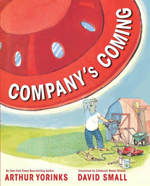 Thirty years ago, Company’s Coming introduced readers to Shirley and Moe, whose preparations to host a family dinner party are interrupted by the arrival of a flying saucer in their backyard in Bellmore. Shirley, believing the pair of aliens is friendly (they do come bearing a gift), invites them to dinner. Moe is more apprehensive and notifies the authorities. Before they know it, their house is surrounded by the FBI, the army, the air force, and the marines. Found harmless, the spacemen join Shirley and Moe’s guests and enjoy a friendly spaghetti and meatballs dinner. A new edition of the sequel, Company’s Going (originally published in 2001), was released simultaneously.
Thirty years ago, Company’s Coming introduced readers to Shirley and Moe, whose preparations to host a family dinner party are interrupted by the arrival of a flying saucer in their backyard in Bellmore. Shirley, believing the pair of aliens is friendly (they do come bearing a gift), invites them to dinner. Moe is more apprehensive and notifies the authorities. Before they know it, their house is surrounded by the FBI, the army, the air force, and the marines. Found harmless, the spacemen join Shirley and Moe’s guests and enjoy a friendly spaghetti and meatballs dinner. A new edition of the sequel, Company’s Going (originally published in 2001), was released simultaneously.
—LC
Dress Up and Let’s Have a Party. Remy Charlip. 2018. Enchanted Lion.
 In this classic picture book, John and his friends find creative ways to dress up for a party. The children convert common household items into clever and inventive costumes and make grand entrances in the colorful illustrations. With the amount of time young children spend in exploratory and imaginative play continuing to decline, Remy Charlip’s first book (back in print for the first time since its original publication in 1956) endures as a reminder to young children of the fun that can be had anywhere, anytime—as long as they use their imaginations.
In this classic picture book, John and his friends find creative ways to dress up for a party. The children convert common household items into clever and inventive costumes and make grand entrances in the colorful illustrations. With the amount of time young children spend in exploratory and imaginative play continuing to decline, Remy Charlip’s first book (back in print for the first time since its original publication in 1956) endures as a reminder to young children of the fun that can be had anywhere, anytime—as long as they use their imaginations.
—LC
A Grain of Rice. Helena Clare Pittman. 2018. Delacorte/Random House.
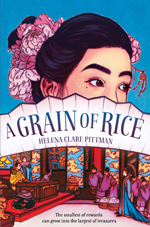 In Pittman’s original tale set in 15th-century China (first published in 1986), Long Po, the son of a farmer, devises a plan to outwit the Emperor, who fails to keep his promise to allow Long Po to marry the Princess after he creates a potion that saves the ill princess’s life. When the Emperor tells him he can have whatever he wants—except permission to marry the Princess—clever Long Po asks for a single grain of rice, doubled every day for 100 days. The Emperor soon discovers that it’s impossible for him to meet this demand and allows the Princess and Long Po to marry. An afterword explains the mathematical concept behind Long Po’s ingenious request.
In Pittman’s original tale set in 15th-century China (first published in 1986), Long Po, the son of a farmer, devises a plan to outwit the Emperor, who fails to keep his promise to allow Long Po to marry the Princess after he creates a potion that saves the ill princess’s life. When the Emperor tells him he can have whatever he wants—except permission to marry the Princess—clever Long Po asks for a single grain of rice, doubled every day for 100 days. The Emperor soon discovers that it’s impossible for him to meet this demand and allows the Princess and Long Po to marry. An afterword explains the mathematical concept behind Long Po’s ingenious request.
—LC
Intergalactic P.S. 3: A Wrinkle in Time Story. Madeleine L’Engle. Ill. Hope Larson. 2018. Farrar, Straus and Giroux.
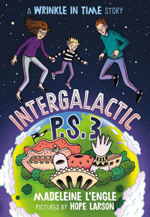 Reissued to coincide with the release of the film version of Madeleine L’Engle’s A Wrinkle in Time, this chapter book tells of an intergalactic adventure two of the Murray children, Meg and Charles Wallace, and their friend Calvin have. Those familiar with the Time Trilogy will recognize Mrs. Whatsit, Mrs. Who, and Mrs. Which, who help the children travel from Earth to a different galaxy to attend school at Intergalactic P.S. 3. In this brief story, originally published in 1970 and later developed by L’Engle into A Wind in the Door (1973), Meg must solve a particularly unusual entrance exam for the school to ensure that all three children can safely remain on the Framoch planet.
Reissued to coincide with the release of the film version of Madeleine L’Engle’s A Wrinkle in Time, this chapter book tells of an intergalactic adventure two of the Murray children, Meg and Charles Wallace, and their friend Calvin have. Those familiar with the Time Trilogy will recognize Mrs. Whatsit, Mrs. Who, and Mrs. Which, who help the children travel from Earth to a different galaxy to attend school at Intergalactic P.S. 3. In this brief story, originally published in 1970 and later developed by L’Engle into A Wind in the Door (1973), Meg must solve a particularly unusual entrance exam for the school to ensure that all three children can safely remain on the Framoch planet.
—LC
Stellaluna. Janell Cannon. 2018. Houghton Mifflin.
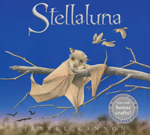 Stellaluna, a baby fruit bat who is accidentally dropped by Mother Bat during an inflight attack by an owl, is fortunate to land in a nest full of fledglings. Stellaluna attempts to fit in by adapting to the behavior of the family of birds until she happily is reunited with her mother. The artwork has been enhanced by the coloring of ink drawings in this 25th anniversary edition, which includes an updated “Bat Notes,” an access code for downloadable crafts and activities, and a note from the author.
Stellaluna, a baby fruit bat who is accidentally dropped by Mother Bat during an inflight attack by an owl, is fortunate to land in a nest full of fledglings. Stellaluna attempts to fit in by adapting to the behavior of the family of birds until she happily is reunited with her mother. The artwork has been enhanced by the coloring of ink drawings in this 25th anniversary edition, which includes an updated “Bat Notes,” an access code for downloadable crafts and activities, and a note from the author.
—CA
Strega Nona’s Magic Ring. Tomie DePaola. 2018. Simon & Schuster.
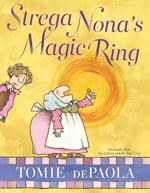 Reissued with updated cover art and a new title, this story (originally published in 1979 as Big Anthony and the Magic Ring) recounts the misadventures of Strega Nona’s helper, Big Anthony, who uses Strega Nona’s magic ring to turn himself into a handsome stranger. Big Anthony heads out for a night of dancing, but soon discovers that the magic of the ring has worked a little too well! In this sequel to Tomie dePaola’s Strega Nona (1975), young readers learn what can happen when one receives more than what they bargained for.
Reissued with updated cover art and a new title, this story (originally published in 1979 as Big Anthony and the Magic Ring) recounts the misadventures of Strega Nona’s helper, Big Anthony, who uses Strega Nona’s magic ring to turn himself into a handsome stranger. Big Anthony heads out for a night of dancing, but soon discovers that the magic of the ring has worked a little too well! In this sequel to Tomie dePaola’s Strega Nona (1975), young readers learn what can happen when one receives more than what they bargained for.
—LC
Ages 9–11
Champion: The Story of Muhammad Ali. Jim Haskins. Ill. Eric Velasquez. 2018. Bloomsbury.
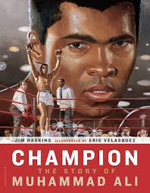 This picture book biography (originally published in 2002) chronicles the life of Muhammad Ali, from his childhood roots in the segregated South to his 1960 Olympic gold medal win and subsequent illustrious boxing career, conversion to Islam, refusal to join the army during the Vietnam War, diagnosis with Parkinson’s disease, and lighting of the Olympic flame at the opening ceremony at the 1996 Summer Olympics. Velasquez’s vibrant oil paintings dominate the pages of this tribute to Muhammad Ali, bringing this American legend to life. The updated timeline in this new edition marks major events of Ali’s life, from his birth in 1941 to his death in 2016.
This picture book biography (originally published in 2002) chronicles the life of Muhammad Ali, from his childhood roots in the segregated South to his 1960 Olympic gold medal win and subsequent illustrious boxing career, conversion to Islam, refusal to join the army during the Vietnam War, diagnosis with Parkinson’s disease, and lighting of the Olympic flame at the opening ceremony at the 1996 Summer Olympics. Velasquez’s vibrant oil paintings dominate the pages of this tribute to Muhammad Ali, bringing this American legend to life. The updated timeline in this new edition marks major events of Ali’s life, from his birth in 1941 to his death in 2016.
—LC
The Enormous Crocodile. Roald Dahl. Ill. Quentin Blake. 2018. Puffin/Penguin.
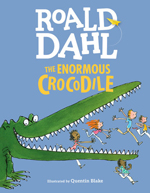 The hungry Enormous Crocodile’s plans to fill his empty tummy by feasting on “a nice juicy little child” are thwarted by other jungle animals—Humpy-Rumpy (a hippo), Muggle-Wump the Monkey, and Roly-Poly Bird—who warn the children to run just as they are about to be devoured. Finally, Trunky the Elephant puts an end to Enormous Crocodile’s clever tricks by using his trunk to swirl him around and around and fling him up to the sun. “And he was sizzled up like a sausage.” The picture book format of this 40th anniversary edition of Roald Dahl’s classic story with Quentin Blake’s signature cartoon illustrations makes it a terrific read-aloud choice.
The hungry Enormous Crocodile’s plans to fill his empty tummy by feasting on “a nice juicy little child” are thwarted by other jungle animals—Humpy-Rumpy (a hippo), Muggle-Wump the Monkey, and Roly-Poly Bird—who warn the children to run just as they are about to be devoured. Finally, Trunky the Elephant puts an end to Enormous Crocodile’s clever tricks by using his trunk to swirl him around and around and fling him up to the sun. “And he was sizzled up like a sausage.” The picture book format of this 40th anniversary edition of Roald Dahl’s classic story with Quentin Blake’s signature cartoon illustrations makes it a terrific read-aloud choice.
—CA
Mr. Popper’s Penguins. Richard Atwater & Florence Atwater. Ill. Jim Madsen. 2018. Little, Brown.
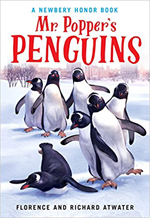 The result of a letter sent to Antarctic explorer Admiral Drake by Mr. Popper, a house painter who dreams of visiting the South Pole, a penguin arrives on the Popper’s doorstep at 432 Proudfoot Avenue in the small town of Stillwater. Crazily wonderful events follow in this middle-grade classic as the penguin, which Mr. Popper names Captain Cook, becomes a member of the Popper family. This 80th anniversary edition of the Atwaters’s delightfully amusing Newberry Honor book has new black-and-white illustrations by Jim Madsen.
The result of a letter sent to Antarctic explorer Admiral Drake by Mr. Popper, a house painter who dreams of visiting the South Pole, a penguin arrives on the Popper’s doorstep at 432 Proudfoot Avenue in the small town of Stillwater. Crazily wonderful events follow in this middle-grade classic as the penguin, which Mr. Popper names Captain Cook, becomes a member of the Popper family. This 80th anniversary edition of the Atwaters’s delightfully amusing Newberry Honor book has new black-and-white illustrations by Jim Madsen.
—CA
The Widow’s Broom. Chris Van Allsburg. 2018. Houghton Mifflin.
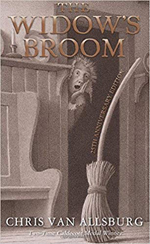 Chris Van Allsburg’s delightfully eerie tale about widow Minna Shaw and the broom she acquires when it is left behind by a witch, who plummets into Minna’s vegetable garden when her old broom loses its power to fly, is out in a 25th anniversary edition. With a beautifully crafted text and exquisitely detailed, textured, sepia-toned artwork, Van Allsburg blends reality and the supernatural as Minna teaches the broom to help with the chores and cleverly tricks neighbor Spivy, who considers the widow’s innocent, hardworking broom to be the wicked tool of the devil.
Chris Van Allsburg’s delightfully eerie tale about widow Minna Shaw and the broom she acquires when it is left behind by a witch, who plummets into Minna’s vegetable garden when her old broom loses its power to fly, is out in a 25th anniversary edition. With a beautifully crafted text and exquisitely detailed, textured, sepia-toned artwork, Van Allsburg blends reality and the supernatural as Minna teaches the broom to help with the chores and cleverly tricks neighbor Spivy, who considers the widow’s innocent, hardworking broom to be the wicked tool of the devil.
—CA
Ages 12–14
The Giver. Lois Lowry. 2018. Houghton Mifflin.
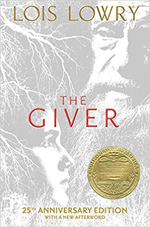 In Lois Lowry’s Newbery Medal-winning fantasy The Giver, after receiving the life-assignment as the Receiver of Memory, 12-year-old Jonas begins to question the colorless, conforming, and controlling sameness of the community in which he lives as he learns from the Giver disturbing secrets about this “perfect” society. The Giver is as provocative today as it was when first published in 1993. This 25th anniversary edition, with a redesigned book jacket, includes a new afterword by Lowry and her Newbery acceptance speech.
In Lois Lowry’s Newbery Medal-winning fantasy The Giver, after receiving the life-assignment as the Receiver of Memory, 12-year-old Jonas begins to question the colorless, conforming, and controlling sameness of the community in which he lives as he learns from the Giver disturbing secrets about this “perfect” society. The Giver is as provocative today as it was when first published in 1993. This 25th anniversary edition, with a redesigned book jacket, includes a new afterword by Lowry and her Newbery acceptance speech.
—CA
If You Come Softly. Jacqueline Woodson. 2018. Nancy Paulsen/Penguin.
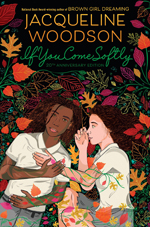 Jacqueline Woodson’s retelling of Romeo and Juliet, which begins when two teens meet accidentally in the hallway of Percy Academy, a Manhattan prep school, on their first day as seventh graders, is an interracial love story of black Jeremiah and Jewish Ellie. In her preface to this 20th anniversary edition, Woodson addresses the relevance of If You Come Softly, with its heartbreaking ending, in light of present-day racism and cases of police brutality in our country.
Jacqueline Woodson’s retelling of Romeo and Juliet, which begins when two teens meet accidentally in the hallway of Percy Academy, a Manhattan prep school, on their first day as seventh graders, is an interracial love story of black Jeremiah and Jewish Ellie. In her preface to this 20th anniversary edition, Woodson addresses the relevance of If You Come Softly, with its heartbreaking ending, in light of present-day racism and cases of police brutality in our country.
—CA
Ages 15+
The Pigman. Paul Zindel. 2018. HarperCollins.
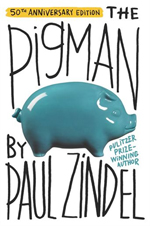 In alternating first person narrations, high school sophomores John Conland and Lorraine Jensen tell the story of a prank phone call to a stranger that leads to their unexpected friendship with elderly Angelo Pignati (the Pigman). Things tragically goes awry when they betray his trust, leaving the teens aware of how their behavior contributed to his death and changing their lives forever. This 50th anniversary edition of The Pigman is the perfect novel to introduce readers to the works of the prolific author of young adult novels, Paul Zindel (1936–2003). Teens will be interested in reading the sequel, The Pigman’s Legacy (1980), too.
In alternating first person narrations, high school sophomores John Conland and Lorraine Jensen tell the story of a prank phone call to a stranger that leads to their unexpected friendship with elderly Angelo Pignati (the Pigman). Things tragically goes awry when they betray his trust, leaving the teens aware of how their behavior contributed to his death and changing their lives forever. This 50th anniversary edition of The Pigman is the perfect novel to introduce readers to the works of the prolific author of young adult novels, Paul Zindel (1936–2003). Teens will be interested in reading the sequel, The Pigman’s Legacy (1980), too.
—CA
Laura Cutler is a Ph.D. student in the Department of Human Development and Family Sciences at the University of Delaware. Carolyn Angus is former director of the George G. Stone Center for Children's Books, Claremont Graduate University, in Claremont, California.
These reviews are submitted by members of the International Literacy Association's Children's Literature and Reading Special Interest Group (CL/R SIG) and are published weekly on Literacy Daily.